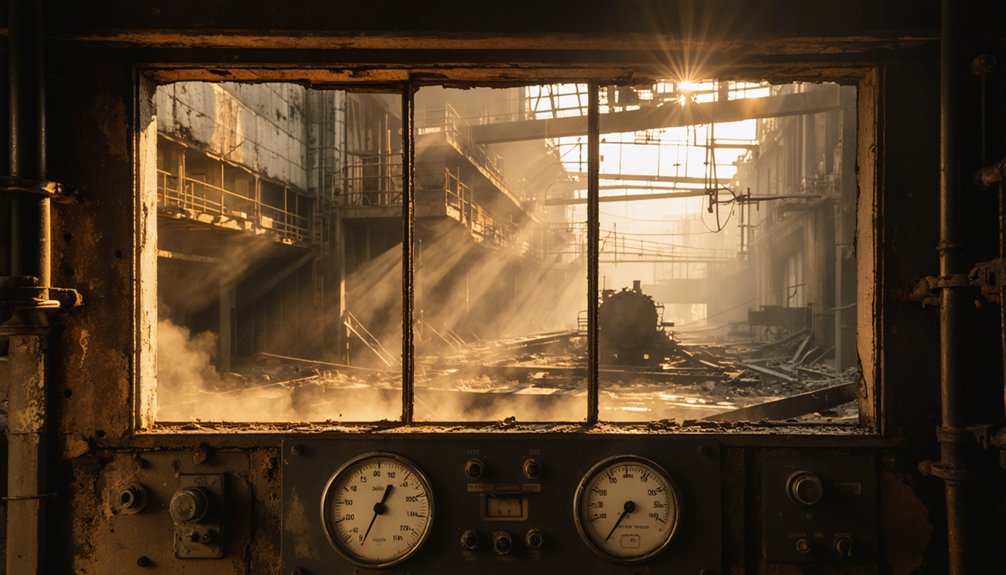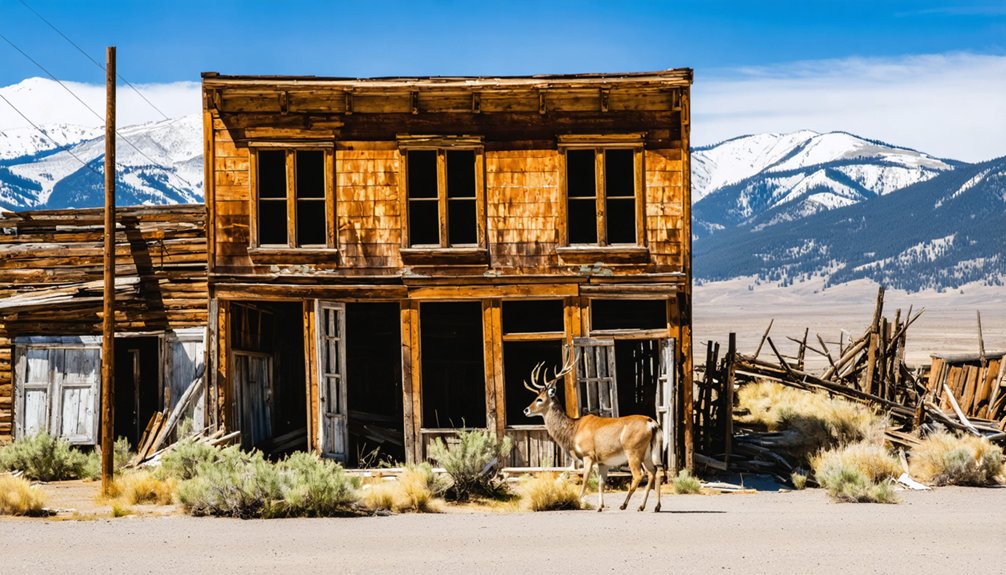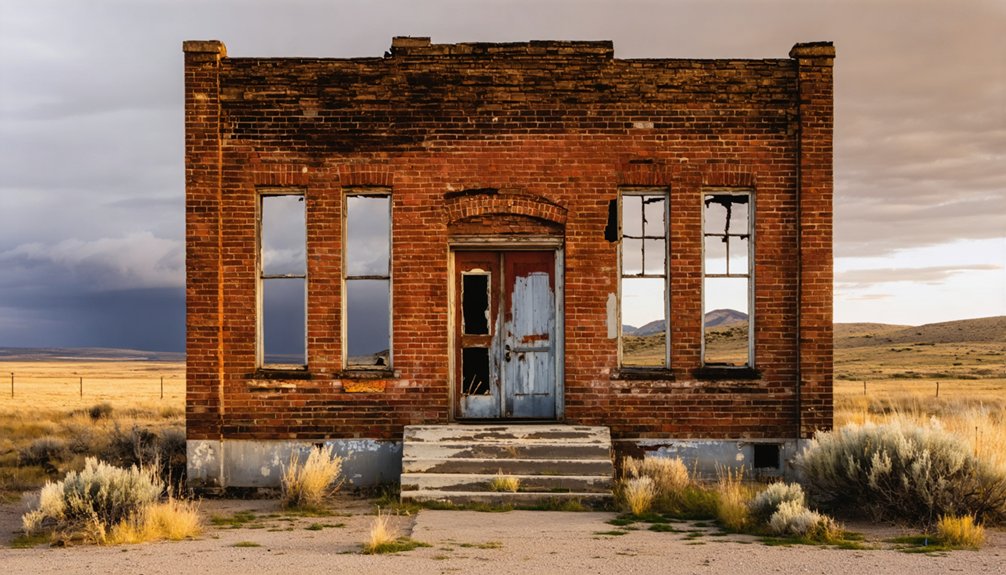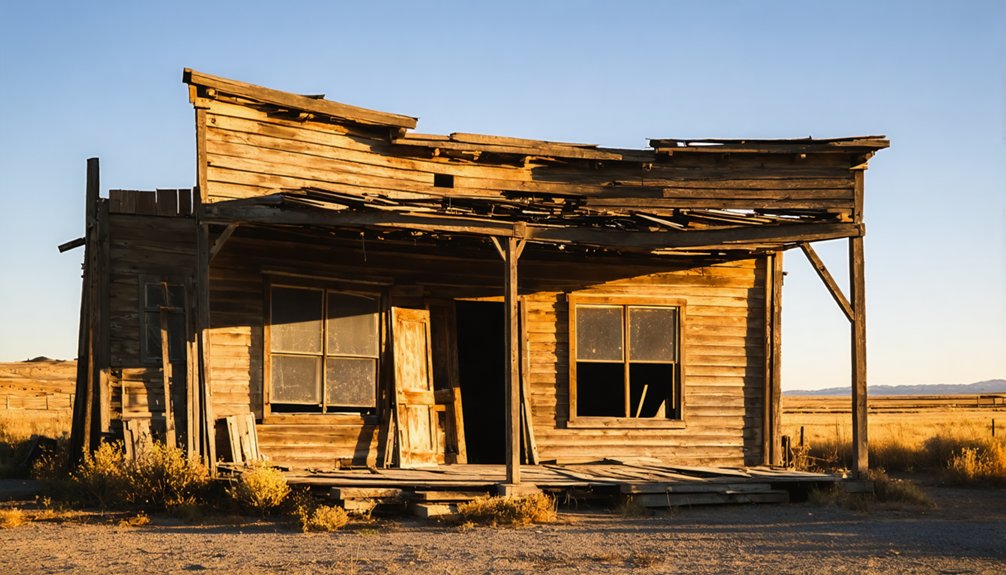You’ll find the ghost town of Gilmore tucked away in Idaho’s Lemhi Valley, where silver and lead mining once drove a bustling community of 600 residents in the early 1900s. Originally called Horseshoe Gulch, the town flourished after the arrival of the Gilmore & Pittsburgh Railroad in 1910. A devastating power plant explosion in 1927, followed by plummeting metal prices during the Great Depression, led to its abandonment. Today, eight preserved structures and a historic cemetery reveal fascinating chapters of Idaho’s mining frontier.
Key Takeaways
- Gilmore became a ghost town after its 1927 power plant explosion and the Great Depression, ending its prosperous silver and lead mining operations.
- The town reached a peak population of 600-1,000 residents during its mining heyday before declining after 1927.
- Eight historic log and frame structures were stabilized in 2010, preserving remnants of this once-thriving mining community.
- The Gilmore & Pittsburgh Railroad, built in 1910, was crucial to the town’s success by connecting it to major transportation routes.
- Originally named Horseshoe Gulch in the 1880s, Gilmore developed around 60 patented mines before becoming abandoned in the early 1930s.
The Birth of a Mining Frontier
While many western mining towns boomed overnight, Gilmore’s emergence in the early 1880s followed a more gradual path.
You’ll find the roots of this remote settlement in its early mining techniques, which centered on extracting valuable lead and silver deposits from roughly 60 patented mines scattered across the rugged terrain.
The town’s economic struggles were evident from the start. Before the railroad’s arrival, you’d have witnessed the arduous process of hauling precious ore by mule teams to the Nicholia smelter, until it burned down.
Mules trudged precious ore along treacherous paths to Nicholia’s smelter, a grueling journey that epitomized Gilmore’s early hardships.
Later attempts with steam-powered tractors proved equally challenging, taking three days and suffering frequent breakdowns.
The Lemhi County Historical Society works diligently to preserve the town’s mining heritage for future generations.
It wasn’t until 1902 that the first cabins appeared, marking Gilmore’s official founding near the major mining operations that would shape its destiny. The establishment of the Gilmore & Pittsburgh Railroad in 1910 finally provided reliable transportation, helping the town grow to nearly 1,000 residents.
From Horseshoe Gulch to Gilmore
You’ll discover that Gilmore’s story began in the 1880s when miners first established a settlement called Horseshoe Gulch high in the mountains.
As the population expanded beyond the original site’s capacity, the community relocated to a lower elevation, creating two distinct areas known as Upper Gilmore and the new townsite.
The town’s permanent name came from Jack T. Gilmer in 1902, though his legacy carried an ironic twist when the Post Office misspelled it as “Gilmore” – an error that would stick throughout the town’s history. The mining operations transported their valuable silver ore to a nearby smelter in Nicolia.
The town reached its peak with a booming population of around 600 residents before mining operations began declining after 1927.
Early Mining Settlement Origins
Located in the rugged mountains of Idaho, the settlement that would become Gilmore began in the late 1880s as a modest mining camp called Horseshoe Gulch.
The early mining techniques centered on extracting lead and silver ores, with mule teams hauling the valuable minerals to a smelter in nearby Nicholia. To support the mining operations, charcoal kilns operated from 1886 to 1888, providing essential fuel for the smelting process.
The community dynamics shifted when falling metal prices forced charcoal production to cease in 1889, temporarily halting mine operations. The site was later renamed in 1902 after Jack Gilmer, marking a new chapter in the settlement’s history.
As the population grew, the settlement relocated from its original position high on the mountain to a larger site at a lower elevation, better suited for the expanding mining community.
Name Change and Growth
As Horseshoe Gulch flourished in the early 1900s, residents petitioned to rename their growing settlement after John T. “Jack” Gilmer, a prominent stagecoach entrepreneur who’d helped develop the region’s crucial transportation networks.
The town development took an unexpected turn when Washington D.C. postal authorities mistakenly recorded the name as “Gilmore” instead of “Gilmer.” Rather than correct the error, locals embraced the misspelling for administrative simplicity.
The town’s historical significance grew as it relocated to a lower elevation, allowing for expanded mining operations and improved infrastructure. The area’s rich mineral deposits attracted numerous prospectors and mining companies.
You’ll find the new site provided better access for ore transport and allowed for larger buildings to accommodate the growing population, which reached about 50 residents by 1909.
The establishment of a post office and general store created crucial hubs for commerce and community life. The construction of the Gilmore and Pittsburgh railroad in 1910 further transformed the town into an important mining transport center.
Post Office Spelling Mistake
When residents petitioned for a new name in 1902, they sought to honor stage line operator Jack Gilmer’s contributions to the region’s transportation network.
However, when the official post office charter arrived from Washington D.C., you’d have noticed something wasn’t quite right – the government had misspelled “Gilmer” as “Gilmore” in the official documents.
Despite the error, the community didn’t challenge the misspelling. The incorrect version, “Gilmore,” became permanently etched into the town’s identity through official postal records and government documentation.
Post offices and communication remained essential to the town’s development and connection to other communities. While the U.S. Postal Service typically maintains strict standards for name accuracy, this spelling mistake remained unchanged. The post office continued operations and served the community until post office closed in 1957.
Today, you’ll find this quirky piece of postal history preserved on Idaho state historical markers, a reflection of how a simple clerical error shaped the town’s lasting legacy.
Silver and Lead: The Town’s Lifeblood
You’ll find Gilmore’s early mining operations centered around rich deposits of silver and lead, which prospectors discovered in 1879 and extracted using primitive methods and mule teams for transportation.
As operations expanded through the early 1900s, the town’s miners relied increasingly on sophisticated underground mining techniques and the newly built Gilmore & Pittsburgh Railroad to move ore efficiently to Montana smelters. The mine site sits at an impressive 7,844 feet elevation, making operations challenging in the mountainous terrain.
The town’s fortunes rose and fell with metal prices, reaching its zenith when silver and lead commanded premium rates during World War I, though the subsequent market volatility contributed to its eventual downfall.
Early Mining Operations Boom
The discovery of rich silver and lead deposits in 1879 transformed Lemhi County’s rugged landscape into a bustling mining frontier.
You’ll find evidence of early mining technology in the underground operations that targeted valuable replacement deposits within the Jefferson and Saturday Mountain Formations, sitting at nearly 8,000 feet elevation.
As economic fluctuations drove demand for silver and lead, particularly for railroad construction and ammunition, Gilmore’s district expanded to include 60 patented claims.
The Portland Mine showcased the region’s potential, shipping ore with impressive grades of 40% lead and 200 oz silver per ton.
Ore Transportation Methods
Moving precious ore from Gilmore’s mines proved a formidable challenge in the district’s early years.
You’ll find that transportation challenges defined the town’s early development, as teamsters hauled valuable ore 85 miles to Dubois using horse- and ox-drawn wagons.
When mechanized haulage arrived in 1906, steam-powered traction engines pulled massive steel wagons, though mechanical failures quickly forced a return to traditional methods.
- Three-day wagon journeys could only operate in summer months
- Each wagon deteriorated rapidly on the rugged terrain
- Traction engines briefly revolutionized hauling before breaking down
- Rail arrival finally provided year-round shipping solutions
The Gilmore & Pittsburgh Railroad eventually connected the mines to regional networks, transforming the isolated camp into Idaho’s largest lead-silver producer outside the Coeur d’Alenes.
Until then, costly transportation ate heavily into mining profits.
Impact of Metal Prices
During Gilmore’s heyday, fluctuating metal prices shaped the town’s destiny as dramatically as the miners who extracted its wealth.
You’ll find that when silver and lead prices soared in the early 1900s, mining investments poured into the region, funding extensive underground operations at 7,844 feet elevation. The mines thrived on shipping high-grade silver-lead ore to distant smelters, but this prosperity hinged entirely on favorable metal price fluctuations.
When metal prices declined, especially after 1929, you’d have witnessed the direct mining investment impact on Gilmore’s fate. The combined effects of the Great Depression and falling silver and lead values made continued operations unsustainable.
With diminished profitability, mines shuttered, triggering a mass exodus that would transform this once-bustling settlement into a ghost town.
Railroad Connections and Transportation
Following its incorporation in 1907, Gilmore and Pittsburgh Railroad Company established an essential transportation link for Idaho’s mining district, connecting remote ore operations to major rail networks.
This railroad expansion transformed mining logistics, replacing inefficient wagon roads with a standard gauge line that could handle heavy ore loads.
Here’s what made this transportation network vital:
- Connected directly to the Union Pacific at Armstead, Montana, enabling efficient ore shipment to distant smelters
- Extended 118 miles through challenging mountain terrain with steep grades
- Reached Salmon by May 1910, marking completion with a golden spike celebration
- Secured funding from Northern Pacific Railway, overcoming the financial hurdles of the 1907 Panic
The railroad’s construction through rugged terrain represented a triumph of engineering and determination, though you’d have faced sharp curves and steep grades during the journey.
The Power Plant Disaster of 1927

A devastating explosion at Gilmore’s power plant in 1927 marked the beginning of the town’s decline into abandonment. The catastrophic event crippled the local mining operations, which had previously generated over $11 million in lead-silver production.
The 1927 power plant explosion devastated Gilmore’s thriving mining industry, ending an era of prosperity in precious metals production.
Without power to run the mines, the town’s primary economic engine ground to a halt.
You’ll find that timing couldn’t have been worse for Gilmore. Just as the community struggled to recover from the power plant disaster, the Great Depression struck in 1929, delivering another brutal blow to the local economy.
Pittsburgh investors withdrew their capital, unemployment soared, and residents began abandoning their homes in search of opportunities elsewhere.
Remaining Structures and Historic Sites
While time has erased many of Gilmore’s original structures, the ghost town still harbors notable remnants of its mining-era past.
You’ll find historical preservation efforts by the Lemhi County Historical Society have maintained several key remaining buildings, including the iconic mercantile building and two churches that stand as a tribute to the town’s once-thriving community.
- Eight log and frame structures received stabilization work in 2010, protecting them from further deterioration.
- The cemetery remains intact, offering a poignant glimpse into the lives of early residents.
- Four untouched structures feature interpretive signage that tells Gilmore’s story.
- The Gilmore & Pittsburgh Railroad terminus site marks where ore-laden trains once departed.
You’re free to explore these historic sites, but remember that many areas are now private property requiring respectful distance.
Natural Beauty and Mountain Landscapes

Situated at an impressive 7,150 feet above sea level, Gilmore’s ghost town rests amid the dramatic peaks and ridges of Idaho’s Lemhi Range.
The rugged terrain beckons you to explore summits reaching over 10,700 feet, including the majestic Gilmore Peak at 10,748 feet. You’ll find endless opportunities for mountain exploration across challenging ridge traverses and rocky prominences.
The area’s natural splendor showcases subalpine meadows bursting with wildflowers, set against a backdrop of dense coniferous forests.
For scenic photography enthusiasts, the panoramic vistas from Gilmore Peak offer stunning views of central Idaho’s wild landscapes. You can capture dramatic shots of sedimentary cliffs, alpine meadows, and glacially carved terrain while sharing the environment with wildlife adapted to these high-altitude conditions.
Preservation Efforts and Modern Access
Preserving Gilmore’s historic character relies heavily on grassroots efforts, with local initiatives like the Gilmore Mercantile GoFundMe campaign leading the charge to save key structures.
The remote location and lack of formal protection status present significant preservation challenges, yet community initiatives continue to maintain this piece of Idaho’s mining heritage.
When you visit Gilmore today, you’ll find:
- Easy access from Highway 28, allowing self-guided exploration of the ghost town
- A well-maintained pioneer cemetery with historical markers and accessible gravestones
- Numerous vacant buildings from the mining era, though some display “No Trespassing” signs
- No entrance fees or formal tours, offering you the freedom to discover the site’s authentic remnants at your own pace
The future of preservation depends on continued local support and potential recognition for broader protection.
The Legacy of Idaho’s Mining Era

Beyond Gilmore’s weathered buildings lies a broader story of Idaho’s transformative mining era, which reshaped the state’s economy and landscape from the 1860s onward.
You’ll find this legacy reflected in the staggering $3.42 billion in mineral production between 1860 and 1969, marking an era of unprecedented economic shifts throughout the region.
Mining innovations revolutionized the industry’s trajectory, particularly when selective flotation in the 1920s solved complex ore separation challenges.
As you explore Idaho’s mining heritage, you’ll notice how the evolution from simple placer mining to advanced lode operations mirrors the state’s technological progress.
The Bank of California’s essential financial backing of these operations helped transform remote mountain outposts into thriving communities, though many, like Gilmore, would later fade into ghost towns – silent testimonies to the boom-and-bust cycle of the American West.
Frequently Asked Questions
Are There Any Reported Ghost Sightings or Paranormal Activity in Gilmore?
You won’t find documented ghost stories or paranormal investigations here. Unlike other ghost towns, there aren’t any widely reported supernatural occurrences, making it more appealing for its mining history and scenery.
What Happened to the Mining Equipment and Machinery After Abandonment?
Like smartphones abandoned mid-text, the mining equipment was left behind after the 1927 explosion. You’ll find rusted machinery scattered across sites today, with most pieces deteriorating from decades of mountain weather exposure.
Can Visitors Legally Collect Artifacts or Minerals From the Site?
You can’t legally collect artifacts or minerals without proper permits due to strict preservation laws. Both state and federal legal restrictions protect the site’s cultural heritage from unauthorized removal.
Which Families Were the Last to Leave Gilmore?
Like autumn leaves slowly drifting away, the last residents included the Denny family and descendants of original Gilmore settlers, who maintained their properties into the 1930s before finally departing.
Are There Any Dangerous Mine Shafts That Remain Open Today?
Yes, numerous hazardous shafts remain open. For your safety, avoid shaft exploration – the area contains over 20,000 feet of unstable tunnels with toxic lead levels and dangerous mine openings.
References
- https://www.youtube.com/watch?v=VCDcNbBZJb0
- https://www.explore.com/1762330/gilmore-settled-rolling-hills-idaho-abandoned-gold-rush-ghost-town-gorgeous-hiking-views/
- https://gilmoreidaho.com/the-history-of-gilmore-idaho/
- https://www.idahomagazine.com/article/gilmores-mines-idaho/
- https://www.visitsalmonvalley.com/historic-adventures/ghost-towns/
- http://www.meadowlakelandcompany.com/files/A_History_of_Gilmore_Past_and_Recent_by_Dick_and_Bob_Moll.pdf
- https://westernlivingjournal.com/ghost-town-ragtown-idaho-gilmores-itinerant-community/
- https://www.idahogeology.org/pub/Staff_Reports/1997/S-97-19.pdf
- https://response.epa.gov/GMWPER
- https://idaho-forged.com/idahos-ghost-towns-eerie-yet-approachable/



